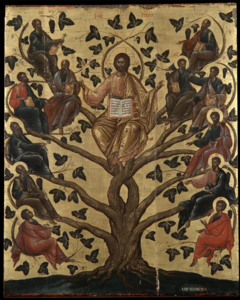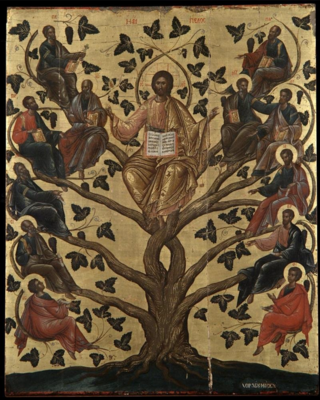
The True Vine is an allegory or parable given by Jesus in the New Testament. Found in John 15:1–17, it describes Jesus' disciples as branches of himself, who is described as the "true vine", and God the Father the "husbandman".
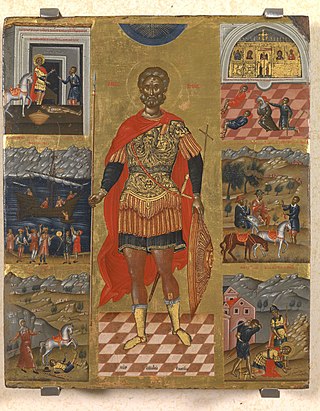
Cretan School describes an important school of icon painting, under the umbrella of post-Byzantine art, which flourished while Crete was under Venetian rule during the Late Middle Ages, reaching its climax after the Fall of Constantinople, becoming the central force in Greek painting during the 15th, 16th and 17th centuries. The Cretan artists developed a particular style of painting under the influence of both Eastern and Western artistic traditions and movements; the most famous product of the school, El Greco, was the most successful of the many artists who tried to build a career in Western Europe, and also the one who left the Byzantine style farthest behind him in his later career.

Theophanis Strelitzas, also known as Theophanes the Cretan or Theophanes Bathas was a Greek painter of icons and frescos in the style of the Cretan School. He passed much of his career as a member of the monastic community of Mount Athos.

Andreas Pavias was a Greek painter and educator, one of the founding fathers of the Cretan School. His works could be found in churches and private collections throughout Italy and Greece, where they influenced countless artists. Seven of these paintings survive today, six bearing Pavias's signature. The most famous of the group is a Crucifixion.

Ilias or Elias Moskos was a Greek educator, shipping merchant and painter from Crete. The last name Moskos was associated with three famous painters of the Cretan School alive during the same period, along with Ioannis Moskos and Leos Moskos, possibly his relatives. Elias incorporated maniera greca with the Venetian style. Theodore Poulakis and Moskos brought the art and style of Crete into the Heptanese School of the Ionian Islands. Some of his work was inspired by Angelos Akotantos. He was affiliated with other artists such as Philotheos Skoufos. He is often confused with Leos Moskos. His son was not Ioannis Moskos although they were probably related. Elias most popular painting is Christ Pantocrator. Fifty-two of his paintings survived.

Ιoannis Apakas, also known as Johann Apakass was a Greek painter and priest. He was active in the latter part of the 16th century to the early 17th century. He was popular artist during his time.
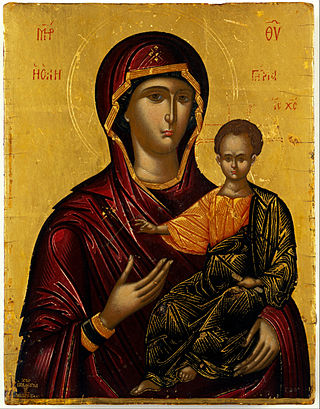
Emmanuel Lampardos, also known as Emmanouil Lampardos and Manolitzis. He was a Cretan Renaissance painter. Emmanuel and his nephew Emmanuel Lampardos have been very difficult to distinguish because they were active painters around the same period. Countless Greek and Italian artists emulated the famous painters. The name Lampardos was very notable in reference to Cretan art. The family was affiliated with famous painters Franghias Kavertzas and Tzortzi Papadopoulo. Lampardos emulated Georgios Klontzas, Michael Damaskinos, Angelos Akotantos, Andreas Pavias, Andreas Ritzos and Nikolaos Tzafouris. His style was the typical maniera greca with a strong Venetian influence. Countless images of the virgin and child have survived. Lampardos influenced Franghias Kavertzas, Emmanuel Tzanes, Philotheos Skoufos Elias Moskos, Leos Moskos, Ioannis Moskos and Emmanuel Tzanfournaris. Over fifty-six icons have been attributed to Lampardos.

Emmanuel Skordilis, also known as Emmanouil Skordilis. He was a Greek Renaissance painter. He was active in Crete around the time Emmanuel Tzanes, Elias Moskos, and Philotheos Skoufos were painting in Crete. He belongs to the elite group of Greek painters that followed the Venetian influenced maniera greca in Crete. Sixty eight of his works survived. He is one of few artists to not travel to the Ionian Islands and participate in the Heptanese School. He eventually settled in the Cyclades on the inland of Milos. Christodoulos Kalergis is another prominent Greek artist associated with the Cyclades, he was from Mykonos. Skordilis was influenced by Georgios Klontzas, Michael Damaskinos and Angelos. Skordilis brought the artistic style of Crete to the Cyclades and influenced countless artists in that region.

Petros Lambardos, also known as Petro Lambardou or Petrus Lambardo. He was a Greek Renaissance painter from Crete. One of the earliest recorded members of the Lambardos family of painters. He comes from a famous family of painters from the island of Crete. Similar to the Bathas, Moskos, and Tzanes family. The family had many notable painters. Emmanuel Lambardos has the largest catalog of works. Two other notable painters of the same last name were Ioannis and Tzortzi Lambardos. The family were major contributors to the Cretan painting style. Three of Petros's paintings survived. The Virgin Mary painting is in Cyprus, Christ the High Priest is at the Benaki Museum and John the Baptist is in Palermo, Italy.

Ieremias Palladas, also known as PouladasIeremia Pallada. He was a Greek Renaissance painter. He was a clergyman, painter, and educator. He was affiliated with Saint Catherine's Monastery in Mount Sinai, Egypt. He is one of the most notable Greek painters of the 17th century. His family consisted of clergy and painters. His nephew was Patriarch of Alexandria Gerasimos Palladas. His work was influenced by Nikolaos Tzafouris and Angelos Akotantos. Georgios Klontzas and Emmanuel Lambardos were active in Crete around the same period. Palladas influenced the works of Theocharis Silvestros, Iakovos Moskos, Ioannis Kornaros and Philotheos Skoufos. According to the Institute of Neohellenic Research, twenty-four of his works survived. His specialty was painting crosses for the iconostasis or templo. Most of his works are in Egypt.
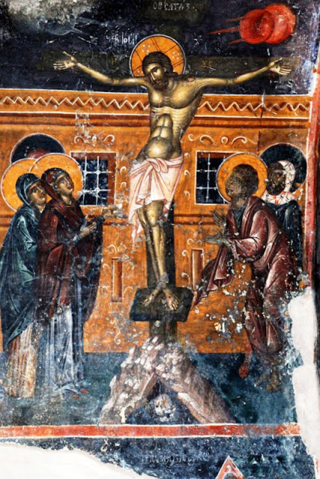
Manuel Fokas, also known as Manuele Fuca, was a Greek Byzantine painter. Most of his frescos have survived until today. Three churches in Crete containing Fokas's frescos are Saint George, Emparaso, Agios Konstantinos Avdou, and Saint George Apano Symi. Artists from Heraklion that his work influenced include: El Greco, Georgios Klontzas and Michael Damaskinos.
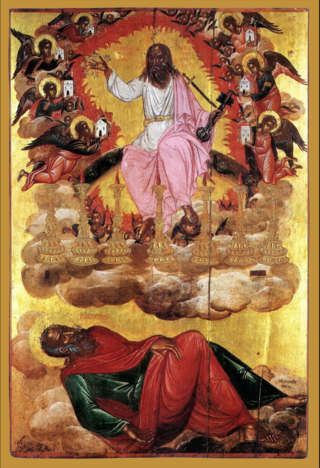
Vision of the Apocalypse, also known as The Revelation of John the Evangelist, is a tempera painting by Thomas Bathas. The massive icon is over four hundred years old. Bathas was from the island of Crete. He was a painter active during the second half of the 16th century. He was active in Heraklion, Venice, and Corfu. He was an important member of the Cretan School. The painting follows the traditional maniera greca. The magnificent icon is on the Greek island of Patmos inside the Cave of the Apocalypse. The mysterious site is believed by Christians to mark the spot where John of Patmos received his visions that he recorded in the Book of Revelation.

The Last Judgment also known as The Second Coming is an icon by Georgios Klontzas. The painting is a depiction of the return of Jesus Christ. The Second Coming is believed to be the final and infinite judgment by God of the people of every nation resulting in the approval of some and the penalizing of others. This painting is a depiction of that event. Klontzas was a Greek artist from the island of Crete. His artistic output was during the second half of the 16th century. He was affiliated with the early works of El Greco. He was one of the most productive Greek painters of the 16th century along with Michael Damaskinos. Klontzas was a member of the Cretan School. Most of his works were copied by other artists. His version of the Second Coming was used as a framework for other artists during the Late Cretan School. Leos Moskos and Francheskos Kavertzas both created similar versions.

Christ the Vine, also known as the Tree of Christ, is a tempera painting by Leos Moskos. Moskos was active from 1620 to 1690. Twenty of his works have survived. He was originally from Rethimno, Crete. He traveled all over the Venetian empire. He worked on the Ionian islands of Cephalonia and Zakynthos. He also worked in Venice. Two other painters with the same last name were active during the same period. They were Elias Moskos and Ioannis Moskos. All three artists painted in the same style. Leos was in Venice around the same period as Ioannis. There is strong evidence that the three were related. Famous Greek painter and historian Panagiotis Doxaras was Leo’s student.
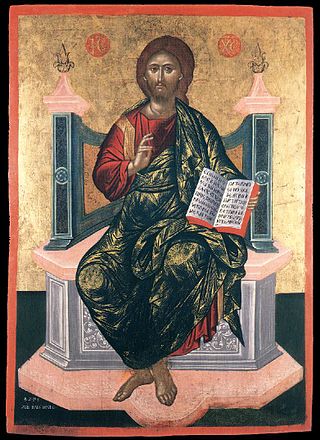
Christ Enthroned is a tempera painting by Elias Moskos, a representative of the Late Cretan School. The artist was also associated with the Heptanese School due to his migration to Zakinthos and the transition of his painting style. Moskos also taught painting. Most of his students became church committee members. Church committees were responsible for commissioning paintings. He was active from 1645 to 1687 on the islands of Crete, Zakynthos, and Kefalonia. Fifty-two of his works survived, over half of them were signed. Two other painters named Moskos were active during the same period Ioannis Moskos and Leos Moskos.

Christ the Vine is an egg tempera painting by Victor. Victor was a Cretan painter active during the 17th century. The painter traveled all over the Venetian empire. He eventually settled in Zakinthos. He is one of the most important painters of the 17th century due to the enormous amount of his existing works. His catalog of art exceeds over ninety-five paintings.

Christ Enthroned is a tempera icon by Emmanuel Tzanes, a Greek painter of the Late Cretan School. It is currently at the Byzantine & Christian Museum in Athens.
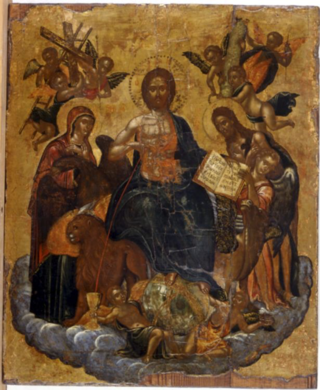
Tribute to the Eucharist was a painting made of egg tempera and gold leaf on a wood panel. The portable icon is attributed to Greek painter Michael Damaskinos. Damaskino's existing catalog features over 100 known works. He was a member of the Cretan school of painting. He was from the island of Crete. His contemporaries were Georgios Klontzas and El Greco. Damaskinos traveled all over Italy for over twenty years. He spent a significant amount of time in Venice. He adopted Italian mannerisms. He applied these new attributes to his paintings. He was friends with sculptor Alessandro Vittoria. He had a collection of drawings obtained from other Italian artists. Namely the Mannerist Parmigianino. He was also exposed to the magnificent works of Italian painter Raphael.

The Dormition and Assumption of the Virgin is a tempera painting created by Elias Moskos. Moskos was a representative of the Late Cretan School and the Heptanese School. He migrated to Zakinthos from Crete. He was originally from the city of Rethymno. He participated in the transition of Greek painting from the Cretan School to the more refined Heptanese School of the Ionian islands. He also taught painting. His activity was from 1645 to 1687. He was active on the islands of Crete, Zakynthos, and Kefalonia. He was heavily involved with church committees. Church committees commissioned paintings. Half of his works were signed fifty-two of his works survived.

Transfiguration and Monastic Scenes is a multi-themed tempera painting created by Greek painter Georgios Klontzas. Klontzas was a Cretan Renaissance painter. The artist was hired to assess work completed by El Greco. Klontzas was from a wealthy family and owned a successful workshop in the center of Crete. His existing catalog consists of Fifty-four works. He completed incredible triptychs and manuscripts. Klontzas and Micheal Damaskinos are two of the most prominent Greek painters of the 16th century due to the size of their catalogs and the popularity of their works excluding El Greco.

